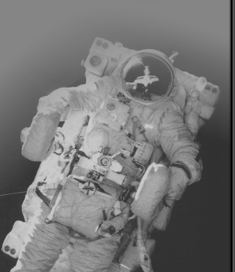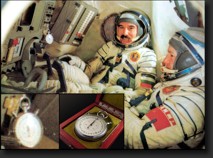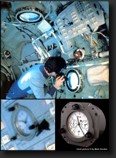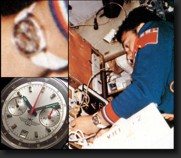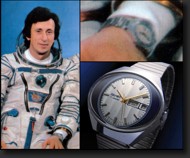|
The First Watch in Space
On April 12, 06:07 GMT, 1961
Juri Gagarin, at the controls of Vostok One, ushered in a new era,
one of manned space flight, and the world was forever changed. The
technology that put this man in space and brought him safely home,
was some of the newest and most modern equipment available.
Ironically, on his wrist was a technology that was already centuries
old-- watch making. It may seem odd to us now in this time of
extremely accurate quartz watches, but at the time, the mechanical
wrist watch was an important piece of gear, and itís accuracy and
reliability were of paramount concern. In light of these concerns,
the choice of watch Gagarin took with him would not have been a
decision made in haste.

The STURMANSKIE, (or ШТУРМАНСКИЕ in
Cyrillic,) which had been issued to new graduates of the prestigious
Orenberg Flight School along with their diplomas since the late 1940ís, was
a logical choice, due to the high quality of the movement and inherent
accuracy of the watch. Gagarin would have been supplied with such a 1st
Moscow Watch Factory Sturmanskie opon graduation from Orenberg as well, but
it is doubtful that he would have received the Sturmanskie he wore into
space at that time. Most likely, he would have been awarded a 15 jewel watch,
very similar to the one he wore in space but lacking some of the newer
features that were unavailable at that time.

Based on an earlier French design, the Lip R26, from which the Soviets
purchased the machinery to produce the watch. The Sovietís had updated the
design by adding a central seconds complication and a hacking feature that
allowed the watch to be precisely stopped and synchronized with a given time
signal. A critical detail on any military watch, but especially so on a
Navigatorís watch, where often location would be ascertained by correctly
estimating where the aircraft was by accurately measuring time to distance.
The Sturmanskie Gagarin wore into space
had a highly finished (including Geneva striping!) 17 jewel, shock protected
movement. The movement was housed in a chrome plated, two-piece case
measuring 33 mm across, 12 mm high, with a 16 mm lug size and had a
stainless steel screw back. Unlike the earlier watchís stainless steel snap
back, the new watch was fully gasketed providing better water resistance.

As a
matter of fact, the Sturmanskieís movement and case, were virtually
identical to the civilian Sportivnie (Спортивные). Only the dial separated
the two watches visually from each other. After his world famous flight, the
watch Gagarin wore was donated to what was soon to become ПОЛЕТ or Poljot,
meaning flight, in honor of Gagarinís groundbreaking mission. Where it
currently resides as part of their present day collection.
In adition to the Soviets putting the first man in space, the Soviets were
also first in putting a women into space as well. On June 16, 1963,
Valentina Tereshkova, on board Vostok 6, spent three days in space orbiting
the earth 48 times before re-entering the atmosphere and parachuting safely
to earth. Tereshkova, seen here in the photo, is wearing what
appears to be a Sturmanskie.

This watch is on display in the
Museum of "Zvezdny Gorodok" (Star City), the Russian cosmonauts training
center near Moscow.
picture copyright by
www.russian-watches.be

Time for a Space Walk
Without question, Gagarinís flight has
left an indelible mark on the annuls of manned space flight. But Gagarin was
not alone in being first among his peers. On June 12, 1965, Cosmonaut Alexi
Leonov became the first person to leave his space capsule and perform a
space walk. He had on his wrist an equally special and well made wrist watch
as the one Gagarin sported.
The Strela, (СТРЕЛА in Cyrillic meaning arrow) was a column wheel
chronograph of an earlier Venus base design. The watch had two registers, a
45 minute elapsed time totalizer and constant seconds hand, as well as a
central chronograph hand that measured seconds. The watch had a chrome
plated, base metal construction and was fitted with a stainless steel snap
back. On early watches, the inside of the watches back are heavily
Damascened, in an engine turned manner. The watch, introduced in 1959 was
originally only available for use by the BBC, the Soviet air force.

The watch was available with various dials with both non-luminous and
luminous types, with tacymetric and telemetric chapter rings. There seems to
be some debate about which version of the Strela Leonov wore. However, most
seem to feel it was either a non-luminous Cyrillic marked watch or an early,
white-dialed luminous piece. The Strela was a central piece of flight gear
issued to cosmonauts for over 20 years, and the watch has gained the
reputation of being the Russian equivalent to the Speedmaster.
This Sekonda was worn by Aleksey
Aleksandrovich Gubarev on the Sojus 28 mission in march 1978.
Picture from the Book
"time capsule"
Copyright OMEGA SA

The Soviets retired the Strela in 1979, three years after the introduction
of their new 3133 caliber chronograph. Recently, new versions of the watch
has been reissued by Poljot. The watches differ in that they are in larger,
all stainless steel cases, and utilize Poljot's 3133 caliber movement. They
are otherwise very faithful renditions of the original watch.
Specific designed
'NII' is an abreviation for
something like 'Science Technical Institute'. There was at least 2 'NII's
associated with watchmaking.
NII-Chasprom was the most elite Horological institute of the Soviet era, who
not only designed and built experimental electronic watches, but also did
the certification of marine chronometers. In the early 1960s NII-Chasprom
made some 'electronic' watches specifically for use in the space program.
The format was 24-hour with date. Whether balance-wheel or tuning-fork is
not explained anywhere, but certainly it wasn't quartz, because such
technology did not yet exist in wristwatch size. A total of 29 were made.
Belyaev allegedly wore one on the Voskhod-2 mission and Artyukhin on the
Salyut 3.

A Changing Tide
The Soviets introduced a new chronograph caliber in 1976. Called the ОКЕАН,
meaning Ocean, the watch was solely intended for use by the BMF, the naval
branch of the military. Later, other official versions, such as the
Sturmanskie, were introduced. Whether or not the 3133 was meant as a
replacement for the Strela, it soon became clear that that was precisely
what it was. Based on the Valjoux 7734 of which the soviets had purchased
the machinery from the Swiss in 1974 to begin their own production of their
new caliber. The new 31 mm movement was a less complex and more robust
movement than the jewel-like 3017. A simple cam design replaced the earlier
watches more complex, and costly to produce, column wheel activation. And
for the first time in history a Russian chronograph was equipped with shock
protection.
At 38 mm wide and 12 mm high, with 18 mm sized lugs, the watch was equipped
with unique crystal that protruded from the case a fairly steep 3 mm high.
The watch came in both chrome plated and stainless steel cases. Stainless
steel cases having stainless steel crowns and pushers and chrome cased
watches chromed crowns and pushers. All early versions of the watch had a
crown at nine that turned a bezel under that purposefully high crystal that
had a second hour chapter ring printed on it, making keeping track of a
second time zone effortless. Like the earlier Strela, many different
versions of the 3133 made there way into space on various missions. Of note
was the ill fated Soyez 23 mission, that left two cosmonauts for dead atop a
cracked, frozen lake bed overnight until rescue teams could safely reach
them.

The 3133 was for official-use only until 1983, when it became available to a
larger public marketplace, including export varients. The 3133 is still in
production today.
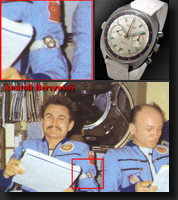
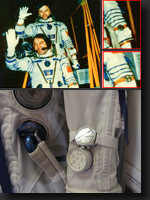
A slight variation of the standard 3133 is the hacking
31659 caliber version Sturmanskie that was, like earlier Sturmanskies, an
air force-only piece. The watch is essentially a standard 3133 that has been
re-engineered with a small lever that applies pressure to the outside of the
balance when the crown is pulled out, freezing the balance and hacking the
watch. Interesting to note, in regard to this watch, is the lack of the
rotating bezel and subsequently the crown at nine.
Below to the left is a picture of Japanese journalist-cosmonaut, Toyohiro
Akiyama taken during his historical flight.

Another Soviet space first, Akiyama was the first private citizen to buy
passage on a space flight. Akiyama was a member of the Soyez TM-11 mission
that linked up with the Mir space station. The cost, a reported 28 million
dollars, was paid by TBS, the Tokyo Brodcasting System. While in space,
Akiyama sent a series of live broadcasts back to the earth. The watch
Akiyama wore was an all stainless steel, Soviet Air Force, 31659 caliber,
hacking Sturmanskie.
Of course, these few watches are not the only watches to be worn by
cosmonauts. Just about any watch that the Soviets produced could have been
worn in space. The list of the watches that were permitted for space flight
was not as strictly regulated as say, NASA does.

And it is not entirely
uncommon to see cosmonauts wearing any variety of seemingly inappropriate
types of watches. So, if the watch kept accurate time and possessed no real safety threat, it
was considered allowable gear.
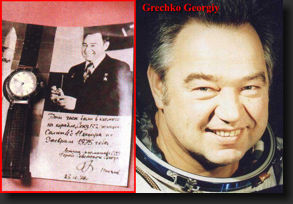
Vostoks and the quartz digital watch, the
Elektronika, (like the one seen on cosmonaut V M Afanasyev in the photo
below),
very often accompanied cosmonauts on their trips to the cosmos almost as
often as Poljotís were.
Digital Watches and the
Soviet Space Program
Based on available
footage it would appear that from about 1980 digital watches enjoyed
widespread use in the Soviet space program. This is most likely due to the
majority of missions being long duration within the confines of a space
station. Under such circumstances, a compact watch with built-in alarm and
chronograph would be highly useful. However an LCD cannot be safely used in
open space, and there have been concerns regarding the shielding of the
electronic components from the ravages of cosmic radiation. So for EVA
duties the standard was, and remains, mechanical watches only.

Pictured above, is a Belarusian-built
Elektronica 52b. The Elektronika watches had quartz digital modules, came in
chrome-plated cases made of base metal. The watches did, however, have
corrosion resistant stainless steel backs.
German Democratic Republic (GDR)
Pictured below is the Ruhla
Intercosmos. The
East German Cosmonaut Sigmund Jšhn was wearing this watch in 1978 on board
of the soyuz-31 Mission.
It was the first analogue quartz wrist-watch generation from the Ruhla
Factory and was very similar to the Ruhla Cal. 24 Mechanical.

Cosmonavigator
This is presumably the only
watch besides the
NII electric that was specifically designed for spaceflight and
actually used for that purpose.
History of creation:
Story by Vladimir А.
Dzhanibekov, twice the Hero of Soviet Union, pilot-cosmonaut of USSR:
"It was
September of 1985. "Salute Ė 7" station. It is midnight in Moscow.
It is also our local time. Maintenance work going on... Ice age. The
Flood at the station has already pasted. Victor Savinyh is cozily
sleeping in a sleeping-bag in front of me. The "deaf" circuits
without communication with Center are going.
- I wonder where we are flying? - I'm asking almost in sleep,
- Above clouds I assume...
Falling asleep I idly
thinking that it would be great to have a watch with globe like the
one at on the central stand. Or, with a map on the dial. But to have
it on my hand... and without need to leave the warm sleeping bag to
check... and soon getting back in again thinking that I was right
and we were actually over clouds and under clouds were waters of the
Atlantic ocean... all right,.. water is there where clouds are. Why
our planet called the Earth and not the Water?.. This was the way
the idea of "COSMONAVIGATOR" was born
That Salyut-7 rescue was a
classic bit of flying by Dzhanibekov. He had to dock the spacecraft to a
tumbling station with no beacon, just a laser rangefinder, sharp eyes and
razor
reflexes.

November 2004 Yuri Shargin has tested his
private Shturmanskie based on a Poljot 31681 movement (complication variant
of the famous 3133) in space expedition.
(Pictures from
www.aviatorwatch.ru)

Gallery of space related watches
and clocks
Unknown watch used
during a spacewalk
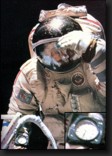

Thanks
to
Kevin (Strela)
for all the writing and the
elaborate
researches
|



